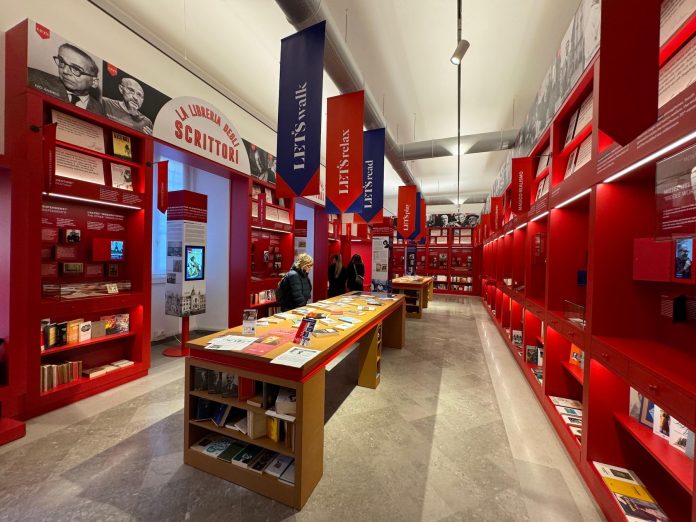by InTrieste
Trieste, the coastal city where Europe’s literary modernism first blossomed, is adding a new chapter to its rich cultural legacy. On Friday, September 13, the LETS Museum—short for Letteratura Trieste—will officially open its doors to the public, inviting visitors to explore the literary heritage of a city that has inspired generations of writers.
Situated at the crossroads of Mediterranean and Central European cultures, Trieste has long been a muse to some of the most influential figures in 20th and 21st-century literature, and now the city has its own dedicated literary museum.
Located in the heart of Trieste, the LETS Museum is poised to become a cultural centerpiece. Its mission: to celebrate the vast poetic and narrative contributions of the writers who have immortalized Trieste, weaving together its diverse cultures and languages. These authors range from the early 20th-century visionary Scipio Slataper to contemporary figures like Paolo Rumiz and Mauro Covacich. Trieste’s literary pantheon also includes internationally renowned voices such as Italo Svevo, Susanna Tamaro, and Claudio Magris, all of whom are deeply connected to this Adriatic port.
Claudio Magris, the esteemed essayist and Germanist, will be among the distinguished guests at the museum’s press preview on September 12. Magris’s presence is a fitting tribute to the museum’s mission; his work has consistently engaged with the city’s complexities and cultural intersections.
The LETS Museum will be open daily from 10 a.m. to 5 p.m., with Sunday hours from 10 a.m. to 1 p.m., offering free admission. The museum will be closed on Tuesdays. Housed within the historic Civic Library of Trieste, the LETS Museum provides a permanent home to a remarkable collection of literary artifacts. The museum represents a fusion of tradition and modernity, incorporating multimedia displays alongside rare manuscripts, letters, and personal items that bring the world of Trieste’s writers to life.
The origins of the literary museums in Trieste trace back to 1997, when Letizia Svevo Fonda Savio, daughter of famed modernist writer Italo Svevo, bequeathed to the city a trove of documents, books, and furniture that had survived the devastation of World War II. This collection formed the basis of the first Museo Sveviano, which opened in the Palazzo Biserini in Piazza Hortis—an area once frequented by Svevo himself.
In 2004, the city commemorated the 100th anniversary of James Joyce’s arrival in Trieste by opening the Joyce Museum in adjacent rooms. Joyce, the Irish literary giant, found a home in Trieste, where he composed portions of his masterworks, Ulysses and Dubliners. Curated by Renzo Crivelli, a leading scholar of Joyce’s work, the museum helped cement the city’s reputation as a literary haven.
For over two decades, these literary museums—alongside the Petrarch and Piccolomini Museum—have drawn thousands of visitors from across the globe. Their relocation to Via Madonna del Mare in recent years has not diminished their allure. Each year, the museums host two significant literary festivals: Bloomsday, celebrating Joyce, and “Buon Compleanno Svevo,” a tribute to Trieste’s own Italo Svevo.
Now, in 2024, as the city marks the 70th anniversary of its reintegration into Italy after World War II, Trieste is poised to inaugurate the LETS Museum, expanding the city’s literary offerings further. The announcement of the museum’s opening came from Maurizio De Blasio, Trieste’s Councillor for Education and Family Policies, who described the new institution as a “home to all the writers who have told the world about the city, its sea, and its territory.”
The LETS Museum’s creation is the result of a broad collaboration, involving key cultural institutions like the Autonomous Region of Friuli Venezia Giulia and Trieste Trasporti. Spearheading the museum’s content curation are renowned academics, including Riccardo Cepach, Cristina Fenu, and Laura Pelaschiar from the University of Trieste, alongside Susan Petri. Together, they have crafted a space that honors the city’s literary tradition while embracing innovative multimedia elements that promise to engage a new generation of visitors.
Central to the museum’s concept is its commitment to the city’s rich cultural diversity. The museum not only celebrates household names like Svevo, Joyce, and Magris but also sheds light on lesser-known yet significant figures, such as Slovenian poet Srečko Kosovel, and the Franco-Italian novelist Fulvio Tomizza, whose works explored the complexities of border identities.
The LETS Museum’s centerpiece will be a new permanent exhibit dedicated to Umberto Saba, the beloved poet and bookseller whose intimate verses captured the spirit of Trieste. The Museo Saba, integrated into the LETS space, will showcase personal objects, letters, and rare editions, offering a deeper glimpse into the life and mind of this iconic figure.
Architect Lorenzo Greppi, who oversaw the museum’s design, has ensured that the LETS Museum is as visually compelling as it is intellectually stimulating. “It’s a dialogue between history and the present,” Greppi explained, referring to the museum’s modern aesthetic, which juxtaposes digital installations with historical artifacts. The museum’s realization is a testament to collective efforts, supported by the library’s staff and archivists, administrative managers, and graphic designers.
As Trieste moves further into the 21st century, it remains committed to preserving its unique cultural heritage. The LETS Museum stands as both a tribute to the city’s literary past and a symbol of its future—where the written word continues to hold sway over the hearts and minds of its people.
For more information, visit the LETS Museum’s official website: https://lets.trieste.it





























